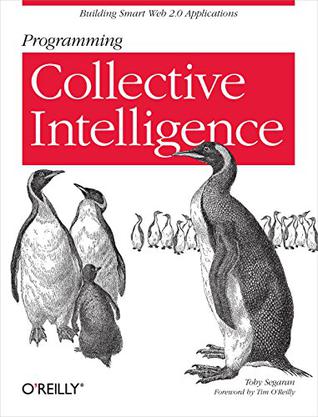-

All of Statistics
WINNER OF THE 2005 DEGROOT PRIZE! This book is for people who want to learn probability and statistics quickly. It brings together many of the main ideas in modern statistics in one place. The book is suitable for students and researchers in statistics, computer science, data mining and machine learning. This book covers a much wider range of topics than a typical introductory text on mathematical statistics. It includes modern topics like nonparametric curve estimation, bootstrapping and classification, topics that are usually relegated to follow-up courses. The reader is assumed to know calculus and a little linear algebra. No previous knowledge of probability and statistics is required. The text can be used at the advanced undergraduate and graduate level. -

Programming Collective Intelligence
Want to tap the power behind search rankings, product recommendations, social bookmarking, and online matchmaking? This fascinating book demonstrates how you can build Web 2.0 applications to mine the enormous amount of data created by people on the Internet. With the sophisticated algorithms in this book, you can write smart programs to access interesting datasets from other web sites, collect data from users of your own applications, and analyze and understand the data once you've found it. Programming Collective Intelligence takes you into the world of machine learning and statistics, and explains how to draw conclusions about user experience, marketing, personal tastes, and human behavior in general -- all from information that you and others collect every day. Each algorithm is described clearly and concisely with code that can immediately be used on your web site, blog, Wiki, or specialized application. This book explains: * Collaborative filtering techniques that enable online retailers to recommend products or media * Methods of clustering to detect groups of similar items in a large dataset * Search engine features -- crawlers, indexers, query engines, and the PageRank algorithm * Optimization algorithms that search millions of possible solutions to a problem and choose the best one * Bayesian filtering, used in spam filters for classifying documents based on word types and other features * Using decision trees not only to make predictions, but to model the way decisions are made * Predicting numerical values rather than classifications to build price models * Support vector machines to match people in online dating sites * Non-negative matrix factorization to find the independent features in a dataset * Evolving intelligence for problem solving -- how a computer develops its skill by improving its own code the more it plays a game Each chapter includes exercises for extending the algorithms to make them more powerful. Go beyond simple database-backed applications and put the wealth of Internet data to work for you. "Bravo! I cannot think of a better way for a developer to first learn these algorithms and methods, nor can I think of a better way for me (an old AI dog) to reinvigorate my knowledge of the details." -- Dan Russell, Google "Toby's book does a great job of breaking down the complex subject matter of machine-learning algorithms into practical, easy-to-understand examples that can be directly applied to analysis of social interaction across the Web today. If I had this book two years ago, it would have saved precious time going down some fruitless paths." -- Tim Wolters, CTO, Collective Intellect -

数据科学实战
• 统计推断、探索性数据分析(EDA)及数据科学工作流程 • 算法 • 垃圾邮件过滤、朴素贝叶斯和数据清理 • 逻辑回归 • 金融建模 • 推荐引擎和因果关系 • 数据可视化 • 社交网络与数据新闻 • 数据工程、MapReduce、Pregel和Hadoop -

模式分类
《模式分类》(英文版)(第2版)简明易读,新增的图表使得许多统计和数学题材非常生动。最终以完美和谐的形式,引导读者深入新的主题。 -

Probabilistic Graphical Models
Most tasks require a person or an automated system to reason--to reach conclusions based on available information. The framework of probabilistic graphical models, presented in this book, provides a general approach for this task. The approach is model-based, allowing interpretable models to be constructed and then manipulated by reasoning algorithms. These models can also be learned automatically from data, allowing the approach to be used in cases where manually constructing a model is difficult or even impossible. Because uncertainty is an inescapable aspect of most real-world applications, the book focuses on probabilistic models, which make the uncertainty explicit and provide models that are more faithful to reality. Probabilistic Graphical Models discusses a variety of models, spanning Bayesian networks, undirected Markov networks, discrete and continuous models, and extensions to deal with dynamical systems and relational data. For each class of models, the text describes the three fundamental cornerstones: representation, inference, and learning, presenting both basic concepts and advanced techniques. Finally, the book considers the use of the proposed framework for causal reasoning and decision making under uncertainty. The main text in each chapter provides the detailed technical development of the key ideas. Most chapters also include boxes with additional material: skill boxes, which describe techniques; case study boxes, which discuss empirical cases related to the approach described in the text, including applications in computer vision, robotics, natural language understanding, and computational biology; and concept boxes, which present significant concepts drawn from the material in the chapter. Instructors (and readers) can group chapters in various combinations, from core topics to more technically advanced material, to suit their particular needs. -

Artificial Intelligence
The long-anticipated revision of this #1 selling book offers the most comprehensive, state of the art introduction to the theory and practice of artificial intelligence for modern applications. Intelligent Agents. Solving Problems by Searching. Informed Search Methods. Game Playing. Agents that Reason Logically. First-order Logic. Building a Knowledge Base. Inference in First-Order Logic. Logical Reasoning Systems. Practical Planning. Planning and Acting. Uncertainty. Probabilistic Reasoning Systems. Making Simple Decisions. Making Complex Decisions. Learning from Observations. Learning with Neural Networks. Reinforcement Learning. Knowledge in Learning. Agents that Communicate. Practical Communication in English. Perception. Robotics. For computer professionals, linguists, and cognitive scientists interested in artificial intelligence.